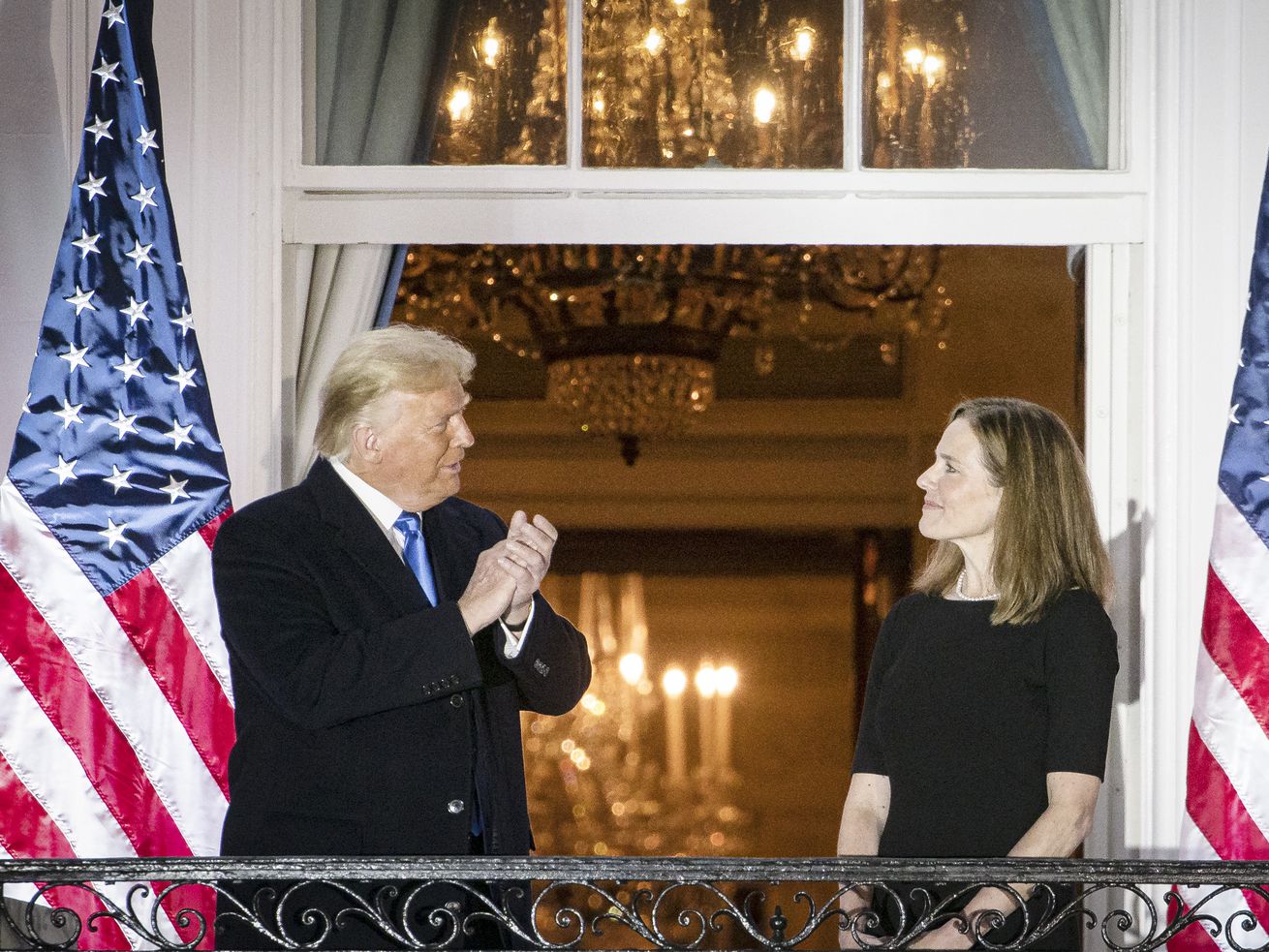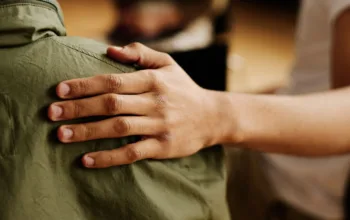And the loss of abortion rights may not even be the most alarming aspect of this case.
Last May, Texas Gov. Greg Abbott (R) signed a state law that effectively bans abortions after the sixth week of pregnancy — sooner than many people learn they are pregnant. This law violates Planned Parenthood v. Casey (1992), which protects “the right of the woman to choose to have an abortion before viability and to obtain it without undue interference from the state. But it will nonetheless take effect on Wednesday unless a court blocks it.
In one sense, the fight over Texas’s anti-abortion law, known as SB 8, is familiar. A Republican-led state enacted a restriction on abortion that violates existing Supreme Court precedents. Pregnant people in the state lose access to reproductive health care — in this case, many clinics have drastically reduced abortions even before SB 8 takes effect. Meanwhile they, and the rest of us, have to wait to see if an increasingly right-wing judiciary will enforce its past decisions or continue to chip away at that precedent.
But the fight over SB 8, which is now before the Supreme Court in a case called Whole Woman’s Health v. Jackson, presents of maze of procedural complexities that are rarely seen in even the most complicated litigation. SB 8 appears to have been drafted to intentionally frustrate lawsuits challenging its constitutionality. And Texas, with an assist from a right-wing appellate court, has thus far manipulated the litigation process to prevent any judge from considering if SB 8 is lawful.
The stakes in this case are astronomical. Six weeks into a pregnancy is often very soon after a pregnant person misses their first menstrual period. So they may not even be aware that they are pregnant until it is too late. According to the abortion providers who are suing to block SB 8, at least 85 percent of abortions in Texas take place after the sixth week of pregnancy. If the Supreme Court does not intervene before Wednesday, Texas’s law will take effect, and these abortions will become illegal.
/cdn.vox-cdn.com/uploads/chorus_asset/file/22817592/GettyImages_1233172250.jpg) Sergio Flores/Getty Images
Sergio Flores/Getty ImagesIndeed, SB 8 imposes such draconian sanctions on abortion providers that all 11 of Texas’s Planned Parenthood clinics stopped scheduling abortions after the sixth week of pregnancy in mid-August, even though SB 8 is not yet in effect. Some other clinics in Texas plan to continue providing their ordinary slate of services until Wednesday, but they will almost certainly cease doing so once SB 8 takes effect.
And the stakes in Whole Woman’s Health stretch far beyond abortion. SB 8 is drafted to frustrate judicial review before the law takes effect. If the Supreme Court embraces this tactic, other states are likely to copy it, potentially allowing states to enact all kinds of unconstitutional practices that can’t be challenged until after an unconstitutional law takes effect.
Finally, it’s worth noting that this case arises on the Supreme Court’s “shadow docket,” a mix of emergency motions and other expedited cases that do not receive full briefing or oral argument. Historically, the Court was reluctant to hand down major, precedent-setting decisions on its shadow docket because of the risk that the justices will hand down an erroneous decision without fully understanding its consequences.
Because altering the Court’s approach to a contentious issue such as abortion in a shadow docket case would be an extraordinary departure from the Court’s normal procedures, it’s possible that a majority of the justices will decide to block SB 8 — at least temporarily. But this Court has a 6-3 conservative majority that is very hostile to abortion rights, so it is at least as likely that the Court will let the law take effect, and effectively overrule key prongs of Casey and Roe v. Wade.
The question in Whole Woman’s Health, in other words, isn’t just whether abortions will remain available in Texas. It is whether the ordinary procedural rules that are supposed to govern all litigation will still be honored by the nation’s highest Court.
SB 8 was drafted to prevent courts from reviewing it
SB 8 is a truly bizarre law.
The way it’s written, a Texan who objects to SB 8 may have no one they can sue to stop it from taking effect.
For one, abortion rights plaintiffs can’t sue their state directly. The ordinary rule is that when someone sues a state in order to block a state law, they cannot sue the state directly. States benefit from a doctrine known as “sovereign immunity,” which typically prevents lawsuits against the state itself.
But they also can’t really follow the same path that most citizens who want to stop laws do. That path relies on Ex parte Young (1908), a decision in which the Supreme Court established that someone raising a constitutional challenge to a state law may sue the state officer charged with enforcing that law — and obtain a court order preventing that officer from enforcing it. So, for example, if Texas passed a law requiring the state medical board to strip all abortion providers of their medical licenses, a plaintiff could sue the medical board. If a state passed a law requiring state police to blockade abortion clinics, a plaintiff might sue the chief of the state’s police force.
Part of what makes SB 8 such a bizarre law is that it does not permit any state official to enforce it. Rather, the statute provides that it “shall be enforced exclusively through . . . private civil actions.”
Under the law, “any person, other than an officer or employee of a state or local governmental entity in this state,” may bring a private lawsuit against anyone who performs an abortion after the sixth week of pregnancy, or against anyone who “knowingly engages in conduct that aids or abets the performance or inducement of an abortion.” Plaintiffs who prevail in such suits shall receive at least $10,000 from the defendant.
SB 8, in other words, attempts to make an end run around Young by preventing state officials from directly enforcing the law. Again, Young established that a plaintiff may sue a state official charged with enforcing a state law in order to block enforcement of that law. But if no state official is charged with enforcing the law, there’s no one to sue in order to block the law. Checkmate, libs.
It’s worth noting that this tactic cannot prevent anyone from ever challenging SB 8. If the law takes effect, abortion providers (plus anyone who “aids or abets” an abortion, a vague term that is not defined in the statute) will undoubtedly be bombarded with lawsuits seeking the $10,000 bounty authorized by the new state law. These defendants will then be able to argue in court that they should not be required to pay this bounty because it is unconstitutional.
But they will do so under the threat of having to pay such a bounty to anyone who brings a lawsuit against them. Even if abortion providers prevail in all of these suits, moreover, they will still have to pay for lawyers to defend themselves in court. And the suits seeking a bounty under SB 8 will likely be numerous and endless, because literally “any person” who is not a Texas state officer can file such a suit.
Once the law takes effect, in other words, it will be too late. Unless abortion providers can obtain a court order blocking SB 8 before it takes effect, those providers are likely to be crushed by a wave of lawsuits that they cannot afford to litigate.
So where does Whole Woman’s Health stand now?
A coalition of abortion providers, advocacy groups, and private individuals did file a lawsuit challenging SB 8 and seeking to block it before it takes effect. The lawsuit names a hodgepodge of defendants, including Texas Attorney General Ken Paxton (R), who has some power to bring enforcement actions against abortion providers after a court determines that such a provider violated SB 8.
The lawsuit also names a Texas judge and a clerk of a Texas court, on the theory that private lawsuits filed under SB 8 will be heard by Texas courts, and thus court officials are the proper defendants under Young. Although lawsuits against judges are typically disfavored, the Supreme Court established in Supreme Court of Va. v. Consumers Union of United States (1980) that judges may sometimes be sued if there is no other way to challenge a state law.
And yet, even though a federal district court determined that the Whole Woman’s Health plaintiffs may sue Texas judges in order to block SB 8, no court has actually reached the core question at the heart of this case: whether SB 8 is unconstitutional.
/cdn.vox-cdn.com/uploads/chorus_asset/file/22817614/GettyImages_1230704283.jpg) Jonathan Ernst/Getty Images
Jonathan Ernst/Getty ImagesThe reason is dizzyingly complex, and difficult to summarize in a concise way. A somewhat oversimplified explanation is that, shortly after the district court ruled that the Whole Woman’s Health litigation could proceed against state judges, but before the district court decided whether to block SB 8, Texas filed an appeal in the right-wing United States Court of Appeals for the Fifth Circuit. The Fifth Circuit then ordered the district court not to decide this case.
The plaintiffs are now in the Supreme Court asking the justices to allow this case to actually be decided either by the original district court of by the Supreme Court itself. Perhaps the justices could decide themselves to block SB 8 — although that outcome is unlikely given the Court’s anti-abortion majority. Alternatively, the justices could lift the Fifth Circuit’s order and instruct the district court to rule on whether SB 8 is constitutional.
This is not how litigation is supposed to work
If you are confused by this morass of procedural aggression, countermeasures to procedural aggression, dueling appeals, and court orders forbidding other court orders, you should be. This is not how the judiciary is supposed to function.
Litigants who face an imminent risk of harm unless a state law is blocked should be given an opportunity to challenge that law before they violate it and risk legal consequences. Appeals courts should wait for lower courts to decide a case before they reach a different conclusion than the lower court might reach. Doctors who provide medical care that, at least for the time being, is still protected by decisions like Roe and Casey should not risk an unending wave of harassing lawsuit brought by people seeking to collect a bounty.
If a court does not intervene before tomorrow, SB 8 will take effect. That means that, if the justices do nothing in this case, they are effectively choosing to rewrite the nation’s abortion jurisprudence without receiving full briefing, hearing oral argument, or taking more than a couple of days to even consider the case.
Just as significantly, they will bless a tactic that could be used to undermine virtually any constitutional right. Imagine, for example, that New York passed an SB 8-style law allowing private individuals to bring lawsuits seeking a $10,000 bounty against anyone who owns a gun. Or, for that matter, imagine if Texas passed a law permitting similar suits against anyone who criticizes the governor of Texas.
Procedural rules exist for a reason. They ensure that every litigant has an opportunity to have their case heard, even if the litigant ultimately does not prevail. They also ensure that courts do not hand down haphazardly decided cases that could impact millions of people.
As Justice Sonia Sotomayor warned in 2020, after her Court handed down a series of unusual shadow docket orders benefiting the Donald Trump administration, shadow docket cases “force the Court to consider important statutory and constitutional questions that have not been ventilated fully in the lower courts, on abbreviated timetables and without oral argument.” They also “upend the normal appellate process, putting a thumb on the scale in favor of” a particular party.
Perhaps most importantly, obedience to procedural norms is a sign of judicial humility. They are the way that judges show us that they are bound by rules, even if individual judges disagree with the outcome dictated by those rules.
There is a case, Dobbs v. Jackson Women’s Health Organization, currently pending before the Court, that presents the conservative justices with an opportunity to overrule Roe v. Wade. That case will receive full briefing and an oral argument, and will likely be decided next June. If the justices want to make abortion illegal in Texas, they only have to wait a few months and they will get their chance to do so through the Court’s ordinary procedures.
If they choose to let SB 8 go into effect this week, by contrast, the justices will send a clear signal that they don’t think the ordinary rules should apply to litigants they dislike. If that happens, it is a terrifying sign about the future of the rule of law.
Author: Ian Millhiser
Read More



